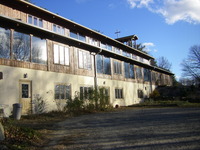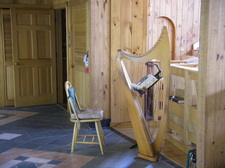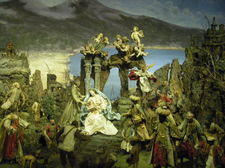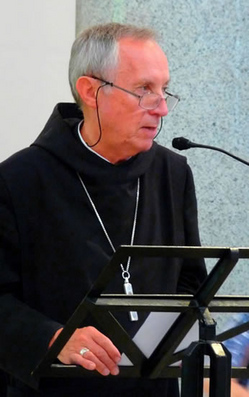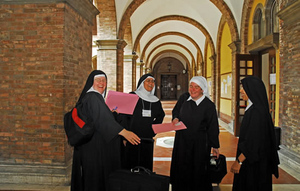For the forthcoming Masses in Germany celebrated by the Pope, Benedictine nuns, Sr Therese and Sr Ruth of Saint Gertrude Abbey are among those who are baking altar breads for the Sacrifice of the Mass.
Tag: nun
Benedict to women religious: testify to your personal encounter with Christ
Here are the central paragraphs the Pope addressed to women religious at the Escorial earlier today.
Dear Sisters, every charism is an evangelical word which the Holy Spirit recalls to the Church’s memory (cf. Jn 14:26). It is not by accident that consecrated life “is born from hearing the word of God and embracing the Gospel as its rule of life. A life devoted to following Christ in his chastity, poverty and obedience becomes a living ‘exegesis’ of God’s word… Every charism and every rule springs from it and seeks to be an expression of it, thus opening up new pathways of Christian living marked by the radicalism of the Gospel” (Verbum Domini, 83).
Continue reading Benedict to women religious: testify to your personal encounter with Christ
Cistercian nun leaves monastery to visit Pope Benedict, first time in 84 years
 A Cistercian nun at 103 years, is leaving the monastery for the first time in 84 years to meet Pope Benedict while he’s in Spain for World Youth Day.
A Cistercian nun at 103 years, is leaving the monastery for the first time in 84 years to meet Pope Benedict while he’s in Spain for World Youth Day.
Oscars 2011 and a nun
 Not surprising that many people are interested in sensational stories like “Mother Dolores Hart: The Nun Who Kissed Elvis Presley.” I guess kissing Elvis is akin to winning the jackpot. Each to his or her own! Thom Geier’s story is exactly titled such on EW.com. I have to admit, however, I am fascinated –to a degree– by this woman’s gesture of following a vocation that had in mind her eternal destiny and not just money, fame and power. Hart’s life and enduring witness to Christ at the Abbey of Regina Laudis, Bethlehem, CT, is inspiring. Who wouldn’t be inspired by a beautiful woman giving her life to God through monastic consecration!
Not surprising that many people are interested in sensational stories like “Mother Dolores Hart: The Nun Who Kissed Elvis Presley.” I guess kissing Elvis is akin to winning the jackpot. Each to his or her own! Thom Geier’s story is exactly titled such on EW.com. I have to admit, however, I am fascinated –to a degree– by this woman’s gesture of following a vocation that had in mind her eternal destiny and not just money, fame and power. Hart’s life and enduring witness to Christ at the Abbey of Regina Laudis, Bethlehem, CT, is inspiring. Who wouldn’t be inspired by a beautiful woman giving her life to God through monastic consecration!
Catholic nun, Mother Dolores has had many jobs: choir member, baker, and coffin
maker. She’s served as prioress, the convent’s second in command, for nine
years. But for the past two decades, she has spent a good deal of time each
winter on another assignment that harks back to her earlier, pre-monastic life:
Oscar voter.”
Autumn days at the Abbey of Regina Laudis
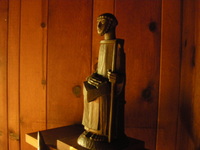 The Abbey of Regina Laudis is a special place in Connecticut; and one of the special Benedictine monasteries in the USA. I’ve been spending more time there in recent months either attending the Divine Office and/or Mass or spending a few days in St Joseph’s Guest House (for men, there are guests for women, married folks, & clergy).
The Abbey of Regina Laudis is a special place in Connecticut; and one of the special Benedictine monasteries in the USA. I’ve been spending more time there in recent months either attending the Divine Office and/or Mass or spending a few days in St Joseph’s Guest House (for men, there are guests for women, married folks, & clergy).

Benedictine sisters meet to discuss the virtue of hope
This week in
Rome the Communio Internationalis Benedictinarum (CIB) for a congress, their
6th, on “Hope in Benedictine Spirituality.”
Benedictine nuns and sisters
from Europe, Africa and America are attending the meeting. The CIB is meeting
on the Aventine Hill at the Primatial Abbey of Saint Anselm (known in Italian
as Sant’Anselmo), home to the Abbot Primate , Notker Wolf (pictured left) who heads the confederation of
Benedictine monks and nuns, the Pontifical Liturgical Institute, the Mabillion
Institute and the college for theological studies for those preparing for
ordination, earning degrees in theology and monastic studies (the general link for all these institutes for higher learning is here).
Zenit ran an
interview today with Sister Maricarmen Bracamontes de Torreon, a Benedictine
sister from Mexico who talked to aspects of hope and how understanding this
virtue is key in Benedictine spirituality, and thus for all Christians. Sacred
Scripture instructs us to look at how God works with us, that is, He gazes on
us with faithfulness, compassion and mercifully. Looking to the holy Rule,
Saint Benedict tells us “not to despair of God’s mercy” (4.74).
Sister Maricarmen said the participants are keenly aware that there is “only
one Benedictine heart beats at the bottom of our universal diversity, and on
the other, there is no doubt that we are going through a historical moment of
darkness and we need a light, precisely like St. Benedict, which shines on high
and gives us clarity in the midst of darkness.”
Two questions of the interview
are worth thinking about here on the Communio blog:
ZENIT: Can we then speak of
a reflection from a holistic-rational perspective?
Sister Bracamontes: The
Benedictine way leads to a process of integration that embraces the different
dimensions of the human conscience: cognitive (the mind), affective (the
heart), ethics and morals (the will and all its capacities), religious (the
soul).
This integration enables us to love in a unified way and it is the
condition to advance on the path of conversion. “However, the workshop
where we must practice all these things diligently is the enclosure of the
monastery and stability in the community” (Rule of Benedict, 4.78). The
monastic dynamic animates the processes of integration in those who live in the
“monastery,” which is the place where we ask God with the most
insistent prayers to bring to completion the divine work of our lives: that
they all may be one.
If we persevere, trying to live in the
“conversatio,” the experience of God’s unconditional love gradually
integrates all the dimensions of our being, and thus we become unified in
ourselves and in the diversity and plurality that characterizes us. The result
of all this is that we live with transparency and consistency, that we do not
separate our judgments from our feelings, or our conduct from our belief. In
this way, our integrity and social and personal responsibility will not allow
us “to say one thing and do another,” or to establish ourselves in a
life of contradictions and inconsistencies.
ZENIT: At present the Church is
facing difficult moments. Does it call for hope?
Sister Bracamontes: Obviously.
I think that some sectors of the Church have slipped up in the dialogue with
the signs of the times that was so encouraged by the Second Vatican Council.
Those
signs have revealed that for centuries, both in the society as well as the
Church, efforts were dedicated to contain diversity and plurality, so
characteristic of humanity. There are many human groups, with different views
of reality; they are arriving on the first plane and ask that they be
recognized, respected and integrated. The new methods of understanding and of
discovery of humanity leave antiquated the old systems of relationship based on
dominion, submission and marginalization. These systems of the past considered
some human beings superior to others, based on race, gender, social class,
ideology, religion, etc.
In face of a clearer awareness of the common dignity
of all human beings, the absence of dialogue between those who are open to the
signs of the times and those who continue to adhere to visions of the past and
close their mind and heart to the historic change that we are experiencing,
calls for hope.
From a perspective of faith, we are conscious and are convinced
that the whole of humanity, with its differences, has been created with equal
dignity in the divine image and likeness. We are children of God and sisters
and brothers among ourselves in Christ, who is our peace (Ephesians 2:14), and
in him all discrimination and marginalization is overcome (Galatians 3:26-28).
From this awareness we hear the call and we open ourselves with wisdom and
maturity to our world with its urgent need to recognize diversity, to promote
integration and to encourage dialogue and participation. Hence, many challenges
arise.
Nuns land record deal
 The Benedictine nuns of the French abbey of Our Lady of the Annunciation of Le Barroux (near the famed Avignon) landed a music contract with Universal Music. This is the same label as Lady Gaga and Elton John.
The Benedictine nuns of the French abbey of Our Lady of the Annunciation of Le Barroux (near the famed Avignon) landed a music contract with Universal Music. This is the same label as Lady Gaga and Elton John.
St Emma Monastery becomes independent
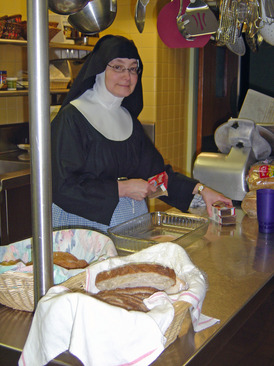 Not long ago St Emma Monastery became an independent monastery after years of being dependent on their motherhouse, Abtei St Walburga, Eichstatt, Germany. Mother Franziska Kloos set the nuns of St Emma’s out on their own now as a canonically established conventual priory! The formal installation with a blessing of Mother Mary Anne by the Bishop of Greensburg, the Most Reverend Lawrence E. Brandt happened on April 18.
Not long ago St Emma Monastery became an independent monastery after years of being dependent on their motherhouse, Abtei St Walburga, Eichstatt, Germany. Mother Franziska Kloos set the nuns of St Emma’s out on their own now as a canonically established conventual priory! The formal installation with a blessing of Mother Mary Anne by the Bishop of Greensburg, the Most Reverend Lawrence E. Brandt happened on April 18.
Monastic Family of Bethlehem and of the Assumption of the Virgin, Livingston Manor, NY
Back in February I received two extraordinary gifts from Brother John Paul, CFR: a weekend spent in a hermitage used by the Franciscan Friars of the Renewal and Brother John Paul’s introduction to a groups of cloistered nuns who live not far away, The Monastic Family of Bethlehem, Livingston Manor, NY. I had for several years appreciated the artwork of the nuns and this was a prime opportunity to meet Bethlehem, as it were, and to experience the sacred Liturgy and to drink in, for a very short time, the beautiful monastic atmosphere.
The nuns in Livingston Manor, New York, call themselves officially, “The Monastic Family of Bethlehem and of the Assumption of the Virgin” founded on November 1, 1950, at Saint Peter’s Square in Rome when Pope Pius XII proclaimed the dogma of the Assumption of the Blessed Virgin Mary. The inspiration of French pilgrims was described in this way:
That throughout the world there may exist religious communities devoted to silent adoration, striving to live in continual reference to what the Virgin Mary lives in heaven where she has been taken up with her soul and her body, into the glory of the Three Divine Persons, hidden for ever with Christ in God.
The monks and nuns of the Bethlehem communities, live the scriptural exhortation to seek the face of Christ by living in the school of Mary. From the Mary, the Mother of God, we learn not to set limits on our love of God and neighbor. This seeking of Christ’s face is discerned in the daily work of community living alone and together, in fraternal and liturgical love, and in the sacred Scriptures. In his letter approving the Monastic Family of Bethlehem, Eduardo Cardinal Martinez Somalo said: “The devote themselves to listening assiduously to the Word of God and to prayer of the heart in a life of solitude, silence liturgical and fraternal communion and humble manual work. In order to be faith to this vocation they receive the twofold monastic tradition of East and West. They are disciples of Saint Bruno, receiving his spiritual fatherhood and wisdom of life. With him they are trained in the school of “Divine Philosophy,” which is Jesus Himself, the eternal Wisdom of the Father. They keep a holy watch awaiting the return of their Lord. Their life, then, is entirely ordered to divine contemplation and the greatest possible love for the Divine Persons and for all human persons.” The point, therefore, is to be progressively likened unto Christ Himself.
Seeking that pearl of great price the monks and nuns of this order seek to live with all their heart the evangelical life, though hidden from the world. Life in the Bethlehem Family is life in an eremitical monastery, meaning each nun (or monk depending on the monastery) lives in a hermitage and the hermitages are connected by a cloister leading the to church, the sign of fraternal and liturgical communion. This vocation, from my one experience of being present at the monastery in New York, is lived intently as it is drawn from what Saint Luke observed in his Gospel “and Jesus withdrew to the mountains and prayed” (5:16). The Monasteries of Bethlehem take Saint Bruno’s Rule and his wisdom of life but they are not Carthusians but are affiliated to them in a bond of charity.
The first community of sisters began in 1951 and the monks’ community was founded in 1976, in the Massif of Chartreuse. In 2007, the Bethlehem Family consisted in 650 members from 33 monasteries through out the world.
Work is essential in this life. You quickly learn that the monastic life -or any other style of life for that matter–is not meant for those who want to rest and relax while supervising the work of others. Each nun or monk is expected to contribute to the shared life. For example, when a new monastery is founded the nuns and monks first build their oratory where the Sacrifice of the Mass is celebrated and the Divine Office is sung. Daily bread is earned, not an entitlement that one sees in other orders. Similar to the average working class family in the world today, the monks and nuns work to sustain their life and glorify God. From something to be avoided or disdained, nuns and monks engage their entire being into the work assigned so that the love of God might be expressed, a sign of trust in the “God the creator of heaven and earth.” Here in New York, the Sisters of Bethlehem earn their living by working with their hands. Through their artwork, they seek to convey something of God’s beauty and truth. Their work itself is accomplished in prayer, praise to the Creator of all things and intercession for all those to whom these items are destined.
The Monastic Sisters arrived in Livingston Manor, New York, in May 1987. The monastery is about 2.5 to 3 hours north of New York City. In this monastery, they earn their living by making medallions, icons and chinaware. They also sell dolomite statues, crèches, crucifixes, and bas reliefs made in the monastery of Mougeres France.
My brothers keep a holy and persevering watch awaiting the return of their Master in order to open to Him at once when he knocks, said Saint Bruno.
As Saint Isaac of Nineve said, “When the Spirit makes his dwelling in someone, this person cannot stop praying, for the Spirit does not cease to pray within him.”
In the solitude of the cell, the monk and nun of Bethlehem has this schedule each day:
1 hour of the liturgical hours
45 min of lectio divina (Bible reading)
1.5 hours of personal prayer
1.5 hours of biblical and theological study
c. 2 hours for 2 daily meals and free time
4-5 hours of work
8 hours of sleep
In the church
1.5 hours for Matins and Lauds
1 hour for Mass
30 min of Eucharistic thanksgiving
45 min for Vespers
Monday is a day of complete solitude and on Sunday there is a meal together with a gathering for a chapter meeting and spiritual conversation.
or
Monastère Sainte Marie Reine des Cœurs
3095, chemin Marie Reine des Cœurs
Chertsey, Québec, J0K 3K0 Canada
or
Monastère Notre Dame de Mongères
F-34720 Caux France
Tel: 33-04-67-98-4486
The motherhouse:
Monastère de l’Assomption Notre-Dame
Currière-en-Chartreuse
F-38380 Saint Laurent du Pont France
Monks tel: 33-04-76-1497
Nuns tel: 33-04-76-4055
From athlete to religious life
 A few weeks ago Yahoo sports posted a story that caught my attention (but I am only now getting around to posting it, sorry) about a former world-class speedskater now on a journey to the vowed life as a Franciscan Sister of the Renewal.
A few weeks ago Yahoo sports posted a story that caught my attention (but I am only now getting around to posting it, sorry) about a former world-class speedskater now on a journey to the vowed life as a Franciscan Sister of the Renewal.



